#made this in ms paint so i now have every layer saved as its own picture. couldn't be assed to port it to photoshop
Text

#worm#wormposting#made this because the bar in hand jumper is called The Underside#made this in ms paint so i now have every layer saved as its own picture. couldn't be assed to port it to photoshop#also made an ant mask version and kept transparent background versions in case of anything#did i fuck up the hair? i tried to make it curly enough but i wasn't sure#i based it off of my own hair which isn't curly
342 notes
·
View notes
Text
had someone ask about my glitter GIFmaking process so i will give! i exclusively use web-based programs, so you don't need to download any software for this!
to preface, my process is a bit convoluted but it's so my images aren't compressed or made fuzzy. ALSO, these steps are for PC.
this is the final result, but you can make basically anything [and probably something prettier than this, i just made this image to demonstrate rotating & resizing pixel GIFs]

tutorial below!
the site i use for glitter backgrounds is online-image-editor.com

click "UPLOAD AN IMAGE" to get your picture in, then click the "Animation" tab. it'll take you to "Add Glitters". click that!

if your image is over 650x650 pixels, it WILL be rescaled. this is why i only upload images below that size, but it's up to personal preference and the compression isn't that bad unless you're using pixel art.
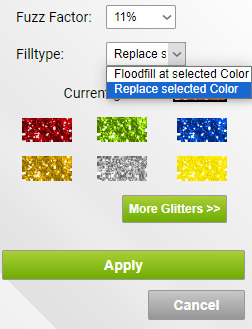
here are the settings i use when filling with glitter. i always change "Floodfill at selected Color" to "Replace selected Color" because it makes it faster, but it really depends on what you need to be filled. you just click the area on the image that you want to be filled on the preview and it'll be filled

kaoru jumpscare! here's my image so far! i just open the preview into a new tab to save it. it won't be PERFECT but it'll look presentable and that's all that matters.
NOW, for adding GIFs to this unsuspecting kaoru, i use photopea.com. i usually use GIFcities.org, glitter-graphics.com or tumblr to find GIFs. where the GIFs are from doesn't matter, just make sure you save them as GIFs onto your computer.
when you upload your GIF into photopea, you might realize that it's not moving anymore!

this is OK, it will be a GIF when you export it. if your image is not exported as a gif, make sure that all the frames of each single animation are in the same folder, and all begin with "_a_".
IMPORTANT because i didn't initially include this, but i recommend you duplicate every layer of your background image 1-3 times if you're inserting GIFs with a relatively higher count of frames so the glitter doesn't flash like crazy when you export. to duplicate layers, select a layer and "Ctrl+J". do this for every layer that doesn't have "copy" in its name first then repeat so you don't duplicate the wrong layers.

to open a new GIF or image, you go to "File", then "Open..." . note that you can do this with multiple images/GIFs in one go!

to add the GIF to the image you want edited, make sure you have selected the folder. go to "Layer" then "Duplicate Into ..." and make sure you duplicate to the image you are editing.

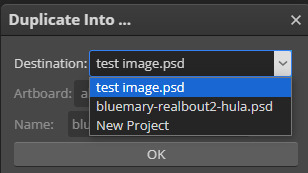
if you go to the image, it should contain a new folder containing all the layers from the image you duplicated from.
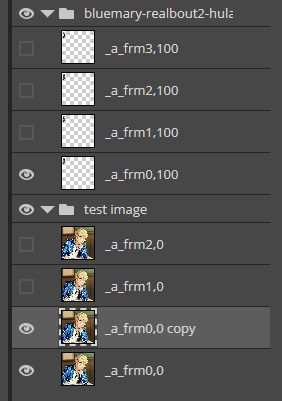
if you want to move the GIF, select the folder and use "Ctrl+Alt+T" to transform. if you only move the GIF it should not turn fuzzier, but if you want to resize the GIF i usually use ezgif.com/resize with the Gifsicle setting for "Resize method".

you can rotate GIFs by exact 90 degree increments if you hold the "Shift" key while rotating in photopea, however any other rotation WILL make your image fuzzier, and it's a bit harder to rotate the GIF but is possible!
i use ezgif.com/rotate for this, you can do any rotation you want but i did this one.
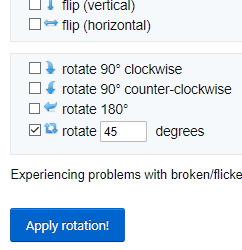
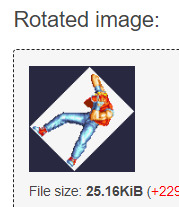
OK! it's rotated, but there's an annoying navy border so i'll show you how to get rid of that! DON'T bother saving the GIF you have just made, go from "Rotated image" and click "more tools", then "Remove background"
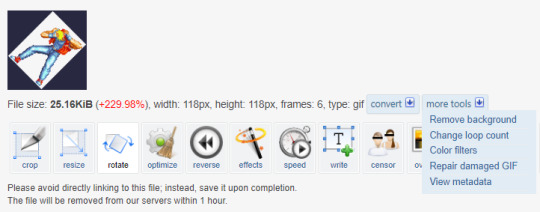
assuming you get the same navy as i do, the HEX code is #282840, but you can get you own hex code by converting the RGB to HEX [or getting a hex colour picker to work, didn't work for me. you can get the RGB by screenshotting and using MS paint]

voila! it is now transparent!
after you've added all your images in and you're satisfied with your image, you should select all the layers by holding "Shift" and selecting the top and bottom folders
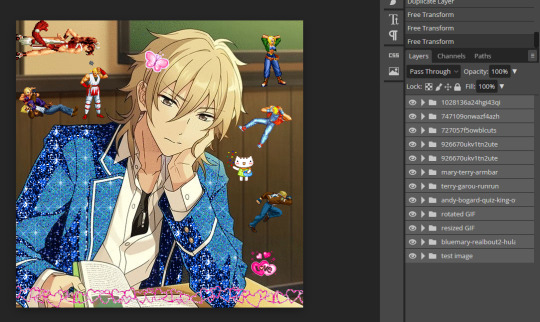
and then, you go to "Layer", "Animation" then "Merge". you can always undo this and make edits so do not freak out if you've realized you want to edit parts

now, your GIF is ready to be exported!

go to "File", "Export as" and select "GIF"!
it'll take a while for it to load in, and you might notice an immediate issue! the GIF is too fast! you can fix this by messing around with the speed dial. this is the most frustrating part of GIF making for me because my computer is slow and freezes a lot. just stay patient, and do NOT reload your browser or you'll lose all your hard work!
annnddd that's it! bye bye!

#tutorial#glitter gifs#glitter graphics#glittercore#GIF#gif tutorial#kaoru hakaze#ensemble stars#fatal fury#hope this is helpful
13 notes
·
View notes
Text
Rainbow Part 2
Requested by Anonymous
Pairings: Lena Luthor x Reader
Tags: Fluff, Humor, Just Cuteness All Around
Working for Lena was great, amazing in fact! Though you admired Lena for her work ethic and genuine friendly attitude, you always wondered how someone as kind as she, could result from a family so vile. It didn’t make sense to you. But you spent less time wondering about her family’s legacy, and more about her as a person. Lena was so strong, her resilience to the hate people gave her because of who she is, made your heart flutter in a way you haven’t felt before. You never had the pleasure to interact with her before she found you with the little boy. You’d only heard rumors and whispers of how she acted. But now that you work for her, you see, now, that others opinions don't do her justice. Lena Luthor deserved so much more.
After several weeks of working for her, she asked you to commission a mural in Supergirl’s honor. For what you could see, Lena was in the process of buying abandoned and foreclosed properties to refurbish them and offer them for philanthropy. A part of that project was to create a mural, just a way to say thank you to Supergirl for everything that she’s done for National City. To have a resident superhero was great. Seeing her insignia gave people hope. ‘Stronger Together’ is what it meant, so that’s the emphasis you were going to put into the painting. When Lena gave you creative freedom, you already had the painting in mind, it taking shape with a will of its own. You were going to paint Supergirl mid flight, with one arm outstretched and one leg bent, her red cape fluttering in the wind. It was already detailed enough but you were going to put special prominence on her insignia, her facial features, and draw ‘stronger together’ in big red lettering with a gold outline below her regal form.
The next day, you got to work, already dressed in your painting flannel and jeans. Your supplies surrounded you, a mess to some people, but to you, it was your own personal paradise. The smell of acrylic was soothing to you, and every stroke of your brush was artistic therapy. By the time Lena came over to check on you, you already had a basic outline done using black paint and a thinner brush. This stage was always the most depressing to you because, right now, it didn’t look like much, but it was a wall of opportunity, a blank slate, a chance to turn something mundane into something truly spectacular.
“How’s it going?” Lena asked you as she got closer and you couldn’t help your smile. She was truly amazing, and you couldn’t say it enough.
You saw that she had burgers for you, and you smiled, sticking your brush into your hair so you wouldn’t lose it.
“I promise it’ll be awesome! I’ll have more for you by then end of the day.”
Lena smiled sweetly at you, admiring your enthusiasm.
***
Lena couldn’t get you out of her mind. Every waking moment of her life was filled with thoughts of you. How were you doing? Were you okay…? Were you single?
She was still trying to play it cool and not seem utterly obsessed. That would be so creepy. She just wanted to spend more time with you. The idea that maybe you hadn’t eaten in a while flitted across her brain and she latched on to it, using any excuse to see you. So, when Lena saw you, with your food in tow, her heart flipped in her chest.
Watching the sunshine on you and highlight your hair was breathtaking. She watched you work, nimble and skilled fingers moving the brush with such grace that a ballerina would be jealous of. This was her favorite part of her day: watching you work. The air of serenity that surrounded you like an aura was beautiful. You were at your most tranquil when you painted. Lena could see the artwork come alive through your eyes and it was then that she realized that she was in love with you.
Lena squared her shoulders and frowned. It was one thing to experience love at first sight, but to be in love? That was ridiculous. Luthors can’t love. They don’t have it in their DNA to experience such a feeling. The closest she could get to love was quite possibly obsession and that was a hard pass for her. The only thing she was completely committed to was her work. So, she shook off her confusing feelings, stored them in little boxes, and approached you.
“How’s it going?”
***
Lena convinced you to take a break. Well it didn’t take much convincing. You truly liked Lena. She was a strong and admirable person that beat all odds stacked against her and tried to make a name for herself outside of the Luthor legacy. You also noticed several other things about her. Her skin was flawless except a lone freckle that adorned her neck. When she would get frustrated, she would always put her hair in a ponytail…and when she was with you, she blushed a lot. As you two were eating, you noticed how she would react when you compliment her work or tell her that she’s doing a great job. You also knew that something inside you was falling for this regal woman. She was utterly beautiful, gorgeous. Something about her perseverance was intriguing and what reeled you in was her personality. Working for her was the best decision you’ve ever made. She saved you in more ways than one.
Now that you knew that there was something between you, a spark of sorts, you began to devise a way to fan it into a flame.
“Ms. Luthor, would you like to help me paint?” you offered to her. Lena stuttered and then laughed.
“Oh no I don’t wish to be in the way,” she said with a mouthful of burger. “Besides I’m not wearing anything to paint in.”
That much was very true. She was dressed in formal wear with a blouse, a skirt, and her signature high heels. Before you could talk yourself out of it, you’re shrugging out of your flannel and offering it to her. Lena’s eyes grew big, her green orbs looking at your shirt and then at you in a tank top.
“I insist,” you encouraged.
Thirty minutes later, you had Lena wheezing from laughter. She insisted that she do the easier tasks like painting the bigger shapes while you take care of the detailed work. You were currently telling her this corny joke that you learned from social media and the next thing you knew, her face was as red as a lobster and she was clutching her stomach.
“Y/n, that was awful!”
You giggled and bowed for the job well done before turning back to your work. It didn’t take long for Lena to abandon her heels. She opted to work barefoot instead, her feet pale in comparison to the sidewalk. For several minutes, you worked in a comfortable silence until Lena called your name.
“Y/n?”
You turned just in time to see her flick some paint in your direction. The red droplets splattered into you neck and chest thickly and you couldn’t stop the gasp that escaped you. Lena laughed at your reaction, her hand coming up to hide her own sheepish smile. You were quick to recover, and you cracked your knuckles.
“Oh Luthor, it is on!”
You knew you had to be careful of her skirt, so you dipped your hand in blue paint and flicked your fingers towards her. Lena laughed boisterously as she used your flannel to shield herself. She ran away, ducking and weaving so she could avoid you, but that didn’t stop you from gently tackling her. You twisted your body so that she would land on top of you and you both laughed on the way down. When you finally calmed down, you’re aware that Lena isn’t laughing anymore. You open your eyes to see her staring into yours, her eyes wide with an emotion you couldn’t read, but you could see her vulnerability. Lena swallowed repeatedly, her eyes flitting from yours to you lips and back again. You smiled, your hand rubbing her back through her borrowed flannel.
“Lena?” you asked, and you swear you could feel her heart rate increase.
“Yes?” she whispered.
“I hope I haven’t read this evening wrong,” you began, your own nervousness manifesting itself as a shaky voice.
“But I’ve thoroughly enjoyed spending this time with you. And I hope-”
You paused, your throat suddenly dry. Lena placed her hands on either side of you head and you became increasingly aware of the fact that she was straddling you, her body heat seeping past your own layers of clothing to ignite your skin on fire.
“Yes, Y/n?” she asked, prompting you to continue.
“May I take you out on a date?”
“Yes!” Lena said quickly before she cleared her throat and chuckled in embarrassment.
“Yes,” she said again, attempting to be calm. “I would like that very much.”
You’re all smiles as you stood up and helped Lena to do the same.
“I know I pale financially in comparison to you-” you began, but Lena didn’t let you finish.
“I don’t care about that. Besides, money isn’t what made me fall in love with you,” she said before she slapped her hand over her mouth.
You’re speechless, your mind a literal Windows blue screen before you force it to reboot and form words.
“You love me?”
Now that the cat was out of the bag, there was no way Lena could go back. It was now or never. She knew that she put herself in this situation, this moment of vulnerability. Even now, she could feel herself build her walls and close herself from being exposed. It took everything in Lena to not do that, to not shut you out. Not everyone was Lillian or Lex, and everyday was a battle to not treat people the same way as they’ve treated her.
Lena couldn’t speak quite yet. All she could do was nod her head and not pass out from nervousness. Your heart soared and you held her hands.
“Lena,” was all you could say before you engulfed her in a hug. Lena gasped, her body freezing in shock before she hugged you back. And that’s the way you stayed for several minutes, locked in an embrace and feeling like you couldn’t get closer to the woman you loved no matter how hard you tried. Even with her in your arms, it wasn’t close enough. Holding her was as lovely as you thought it would be. Lena was not weak by any means. You could feel muscle definition beneath the clothes but still holding her, was like holding on to something so precious, that you couldn’t help but be gentle with her. Even you could tell that she was putting a lot into this, forcing herself to be vulnerable with you. You wouldn’t take it for granted.
It’s several more minutes before you’re able to release your hug, just enough to look into her eyes.
“Ms. Luthor, it’s a date then,” you said before kissing her sweetly on her cheek. You were rewarded with Lena’s vibrant red blush, her shaky fingers ghosting where your lips were. Maybe Luthors couldn’t love, but this Luthor was already breaking the mold just for you.
#supergirl fanfic#reader insert#lena luthor x reader#it's so cute#i hope ya'll like it#its another fluffy one
209 notes
·
View notes
Text
hey kids its more ~*Downtrodden Answers*~
heres answers to a few questions that are clogging up my inbox. if i don’t answer yours i’m either writing a long post for it or i’ve already answered it.
its Capital Letters Time.

I’m still working on island legends but I’ve got some tidbits about art I can give you.
Rabbit Art:
Art on the island reflects the roots of language for rabbits in that it’s very tactile. Lango, the most widespread old language on the island, is similar to braille. It was a language meant to be read by touch in the dim warren tunnels and reading visually at all times is actually relatively new, something that started to really pick up in the last one hundred years after interacting with vultures and mainlanders. Even though visual reading became a thing, many books still included thin pieces of wood or thick pieces of paper with raised patterns and textures that were meant to be felt as the story was read. This tradition of ‘feeling’ through art carries on today. Paintings are made with thick layers of paint. Mosaics of textured glass, pottery, and metal line warren walls. Colorful embroidery of plants and bugs and geometric patterns grace the lining of cloaks and inside clothing. Its all about art you can feel in the dark. What isn’t meant to be felt usually produces its own light source in the form of glasswork meant to hold lights or illustrations made with bioluminescent inks. Art pieces that a large amount of people can use or see at the same time are usually more elaborate than pieces meant for individuals, making things like fancy teacups rare and valuable items only given for special events.
Mainlander Art:
Mainlanders typically produce photo-realistic works of art. Things like portraits, taxidermy, elaborate show-weaponry, religious imagery, and landscapes are common. They have good eyes for detail and the artists among them have always held that the best way to express culture and beauty is to make things as true to life as possible. Sometimes artists tend to give reality a little spit-shine for an angry client or disobedient lighting but the ideal is for every painting to resemble a clear window into another space and every statue a living thing (which can lead to some super creepy results). This makes work that features abstraction or symbolism sparse and gives their older children’s books and comics a very particular look since their popular drawing styles aren’t really meant to be simplified. This has changed in recent times since rabbit, hare, and vulture artists intermingling with their community really inspired a lot of illustrators. Body art is also a common practice for things like everyday makeup use (making fur/skin patterning bolder, using kohl eyeliner, males dusting iridescent powders on themselves), special fancy time use (tracing markings with silver or gold inks, fancy nails, painting vows and poetry on themselves for special events), and miscellaneous activities (sex workers, actors, ect. bleaching their skin/fur and drawing new designs on themselves, using people as living canvases).

That’s such a cute image! But rabbits aren’t really the fiddles and flutes type of race. They’re more into things like drums, mbira, and the occasional acoustic guitar. its got a vibe like this and this and this (if anyone knows of anything that kind of fits this vibe let me know) Rich mellow sounds that you can feel in your bones. Sounds that evoke calm in the uncertainty of the outside world and the warmth and safety of dimmed underground lights.
Sounds you can fucking party to.

The island’s signature instrument is the Thumpekha, also known as the dancing drum. Rabbits who play this instrument literally dance on top of it; stomping and hopping with great force while tapping the rim with a pole that they twirl and toss during their performance. Its super tiring to play and traditional dances are actually used for guard training. They’re also a good outlet for the hyperactive and many rambunctious kits get marked for dance practice if they can’t focus on their studies. Thumpekha can be played wearing padded wooden shoes but hardcore rabbits do it barefoot and sometimes even light their poles on fire for an added air of drama and completely unnecessary danger. Thumpekha are mainly played at outside gatherings and special events and have the added benefit of warding off predators. No one is sure why. Something about the vibrations.

Bun names are arranged in three parts.
Given Name/First Name: the name your parents give you. For example, Foxglove. Traditional rabbit names are poisonous plants for two reasons. 1: in the olden days it made memorizing poisonous plants easier. if you have an aunt named foxglove it made you think twice when someone offered you a salad with foxglove in it. 2: it was just seen as good luck to do so. Like, if you took on the name of something poisonous then you were seen as less palatable to predators. These names can be passed down to loved ones or used in memory of someone and encompass different spellings because there are a lot of rabbits and even though you and two of your cousins look up when someone shouts ‘Foxglove!’ at least on paper there are some extra h’s and c’s in there to tell you apart.
Blood Name: the equivalent to a last name that you take from your mother’s side. These names are created from combinations of the names of ancestral mates (say, Oleander and Hemlock which can be something like Olehem or Hemander) and the word ‘root’ (which is spelled differently depending on where you live on the island. Example: root, roote, rute, rhoot, rhoote, rhute, ryute, rhyute). The complete Blood Name would be something like Hemanderroot. People used to combine names when they got married but those names got real long real quick and that practice has mostly ended. There are still rabbits walking around with awful disjointedly long last names though.
Family Name: not everyone has this name and the translation from the old Lango word to ‘family’ is shaky at best. It’s basically the name that can either be given to an adoptee by their new family or chosen for yourself for whatever reason. It is very important to note that these are not nicknames and referring to them as such is pretty disrespectful.

There aren’t any vampires on the island of talking magic rabbit people.
That would be silly.
Mainlanders do have tales of leeches though.
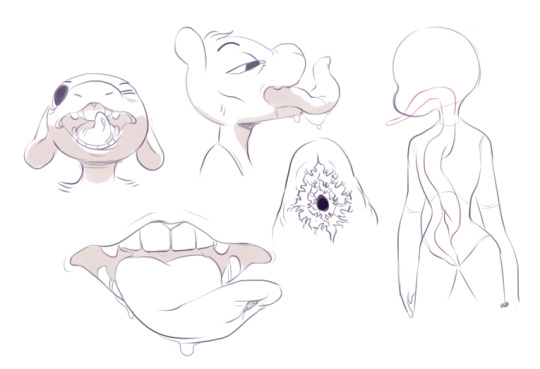
Nasty business. Drinking water from certain lakes and rivers without boiling it first might lead to swallowing a leech egg. A leech egg that hatches and grows and melds with a person’s insides. Imitating the tongue that it eats to nothingness in both function and feeling. Becoming such a part of them that its unclear if they are two separate entities. A leech that this person now needs to keep fed if they don’t want it to tap into their blood stream and kill them both. And it doesn’t need a lot of blood in the grand scheme of things but it needs Enough and it is Unpleasant.
As for sirens, there might have been something on the island that beckoned to people on the water’s edge with convincing words and delicate outstretched hands, but its long gone.

Mainlanders Physically Can’t Come To The Island. There are only a few sapient species that can live on the island without their bodies rejecting the notion of existing there. entire species have been wiped out because they all woke up one day and ran into the sea to try and get away from something that no one has figured out yet. If a mainlander brute forced their way close enough they would black out on their vessel and either wake up swimming/turning around or in rare cases straight up die in a stress induced heart attack. Some people might find this preferable to being misgendered but I’m gonna be real with you, most don’t.

Rabbits have learned that avoidance saves more lives than warfare. Plus, heavy tanks on an island riddled with hidden underground homes probably wouldn’t be great! It could be of use in a mainland war though.

Depending on the water they’d be definitely wet and maybe drowned and sometimes Gone.

If they’re hunted over a long period of time and the scare tactics don’t let up yes. Fear Death is a thing, though they need a long period of intense anxiety for it to take hold.

Answers in order! Nope, Nope, Nope, certain dyes/pelts/metals/magic user services/plants, living bugs and old Ms. Belladonna’s prize winning jam.

Between you and me its an angel but it looks an awful lot like an Alicorn if you squint and listen to the faint whistling of its last shuddering breath.


There’s a joke on the island that every single tree is the same height. This is only half true. Every single tree LOOKS the same height from the coast. Everything is bigger the closer you are to the center.
279 notes
·
View notes
Text
A Graffiti Museum Where the Writers Are in Charge
MIAMI — When Alan Ket was a teenager growing up in the Williamsburg section of Brooklyn in the 1980s, he fell hard for the graffiti that still decorated New York City trains. Sometimes he was the one painting, but more often, he was a detective, figuring out the best locations to snap pictures of the art. On weekends, he’d meet up with friends at a one-hour photo shop on Canal St. to trade negatives and prints of the graffiti photos they’d taken that week.
Preservation was the key. “So many beautiful works of art were being destroyed every week,” he said recently. “It was horrifying.”
At the time, he would cut school to spend afternoons at the studio of Henry Chalfant, who had been the crucial documentarian of 1970s train graffiti. Mr. Chalfant had largely stopped photographing trains, and he implored Mr. Ket and his friends to pick up the baton: “He told us it was up to us to document our own movement.”
Mr. Ket (born Alain Maridueña) took that mandate seriously, and built a life on it, culminating in the opening Thursday of the Museum of Graffiti, in the Wynwood section of Miami, the first institution devoted to telling the art form’s history, as well as documenting its stylistic developments with a curator’s eye for detail.
“We have to be our own authorities,” Mr. Ket, who is the museum’s co-founder, said.
Some graffiti artists of the early era made the transition to galleries, others into commercial design. But for a vernacular art that has seeped widely into popular culture, graffiti — especially as represented by the early pioneers — has made few permanent inroads into established museums. Perhaps that owes to its oppositional nature, and perhaps to its evanescence.
Mr. Ket — known simply as Ket — has no patience for that argument. “Is it key to the essence or is it a response to circumstance?” he asked. “I don’t know. I think all the guys that painted wanted everything to last forever.”
Forever is what he hopes to give them, by way of codifying and organizing the art’s history, with a special emphasis on technique. Too often, graffiti is explained primarily through a sociopolitical lens, so the Museum of Graffiti’s inaugural exhibition, “Style Masters: The Birth of the Graffiti Art Movement,” focuses on first principles — letters as artistic building blocks.
The very first wall is a history lesson on the development of letter-writing styles, accompanied by a photo array of train art from 1972-6 to demonstrate how rapidly the form was changing. (Since there was little documentation within the community, many of the photographs come from journalists who were assigned to capture the emerging art form.)
The rest of the 3,200-square-foot space offers a deeply condensed history of the form, from the early moments in which graffiti writers were applying their talents to canvases — on display is the first painting Lady Pink ever did, from her personal collection — up through the ways graffiti has been used on clothing, skateboards, album covers and more.
The graffiti aesthetic may be widespread now, but Mr. Ket’s read is that of a purist. He has a ferocious zeal to protect the legacy of the underrecognized pioneers, especially as street art — which borrows some of graffiti’s immediacy with little of its charm or technique — becomes more widely known and collected, destabilizing the marketplace and public perception.
That intense historical fanaticism — “a desire to regulate, to keep some kind of stability among the chaos, also to keep a standard of quality,” he said — is, in essence, no different from a formal curatorial approach. For this exhibition, there are no nods to Keith Haring or Jean-Michel Basquiat, widely known graffiti-adjacent artists who Mr. Ket believes are not part of the form’s true history. He has even received pushback from PHASE 2, a 1970s pioneer, who believes graffiti is “a derogatory word,” Mr. Ket said.
Ket respects the disagreement, but moved forward anyhow. “I’m sorry that I’m going to write about you and tell your story and talk about your historical relevancy and your value,” he explained. “I have a responsibility bigger than the individual artist.”
A Marriage of Two Rolodexes
Before moving to Miami two years ago, to manage a gallery connected to the Wynwood Walls, a mural park around the corner from the Museum of Graffiti, Mr. Ket had been a graffiti archivist and advocate in various forms. In the 1990s, he published and edited Stress, a hip-hop and graffiti magazine; he consulted for art exhibitions, and he wrote monographs on important artists.
For decades he’d maintained a personal graffiti archive, and had begun to wonder whether it might be better served at an established institution. “But what good is it if you give it to the Smithsonian and it sits in their warehouse for the next 40 years?” Mr. Ket said. “More people see it at my house.” (Graffiti has appeared at the Smithsonian, but sparingly.)
Bringing the museum to fruition became a full-time preoccupation about a year and a half ago. He met his business partner, Allison Freidin, formerly a prosecutor with the state attorney’s office, as she was doing legal advocacy for graffiti writers. She is his sole outside investor — he holds the majority stake — and quit her job to focus on the birth of the museum.
“Ket is really being called on to tell the story properly. I’m also being called on to make sure that we’re treated properly by everybody,” Ms. Freidin said. Mr. Ket is well-connected among graffiti writers, and Ms. Freidin has extensive relationships in Miami’s art and civic communities. “The marriage of those two Rolodexes is what made this possible,” she said.
A Museum of Living History
One afternoon last month, the exhibition was about halfway installed, and Ms. Freidin had just returned from a meeting with the local review board, looking to address concerns about the museum’s sign. Wynwood comes with built-in tourist traffic, thanks to the Wynwood Walls, but it is not especially known for graffiti, at least not anymore.
In the mid-1980s, graffiti writers flocked to the area. Eventually, the more established art scene followed. “They saved this part of town,” Ms. Freidin said. But now, their work, sanctioned or otherwise, competes with corporate-commission murals, and the industrial spaces that gave way to art galleries are now ceding to clothing stores and luxury dessert spots.
Many local graffiti artists view Wynwood with skepticism, Mr. Ket said. They may also view his project as a kind of carpetbagging. To mitigate those concerns, there is a section of the museum given over to Miami’s graffiti history. “We’ve invited everybody back,” he said.
But Mr. Ket is also counting on the way the graffiti community looks after its own, something he experienced firsthand when in 2007, he was arrested and charged with 14 criminal counts, including trespass, criminal mischief and making graffiti. He eventually pleaded guilty to three counts of criminal mischief and paid $15,000 in fines and restitution. Shepard Fairey, Jose Parla, Futura and others donated art to sell to pay for his defense.
At the museum, he looked around at the people bringing the space to life and noted that the electrician and various maintenance workers are all graffiti writers. He likened it to El Museo del Barrio in East Harlem, founded in 1969 by Puerto Rican educators, artists, and community activists: “I think of those guys and think, we’re doing that, we have to do it for ourselves.” He’s also brought in a full-time curator, Carlos (Mare 139) Rodriguez, to focus on future exhibitions.
“We want to try to keep adding value not just to history, but to living history,” Mr. Rodriguez said. “ That part of this is the advocacy part, right? How do you create value for the art and the byproducts of this art, and also for the artists?”
Given the museum’s focus on the founding generations, “you’re gonna learn about artists that have no fine art career, like zero,” Mr. Ket said, noting that there might be a ripple effect. “It’s not my intention to affect the marketplace, but if that’s the result, I welcome it.”
The Museum of Graffiti just took on its first corporate sponsors: Levi’s and Charlotte’s Web, a CBD company. Stein Paint Company, a local firm, has offered donations of materials for murals.
The museum will generate three revenue streams — ticket fees, the gift shop, and a gallery that will feature new work from a rotating cast of artists who straddle graffiti and fine art. (The first one is Shoe — Neils Meulman — from Amsterdam, who’s developed a style he calls calligraffiti.) There are also 13 new murals, on the museum exterior as well as on nearby walls.
Last month, the graffiti writer turned fine artist JonOne was painting one across the street from the museum, applying layers of pastel blobs to create a festive abstraction. Mr. Ket first encountered his work in 1986, when JonOne was painting train cars with brushes (in addition to aerosol) — “he was the king of the trains,” Mr. Ket said.
JonOne — John Perello — still uses graffiti lettering as the foundation for his work, even as he pushes it toward increasingly abstract ends.
The museum, he said, had a personal meaning as great as its historical meaning: “We’re trying to make sense of all this madness, everything that went on. We’re doing our own little therapy within ourselves.
“It’s like we’re repossessing our history and our culture,” JonOne added. “Finally giving it its just value.”
The Museum of Graffiti opens Dec. 5 at 299 NW 25th Street, Miami; (786) 580-4678; museumofgraffiti.com.
Sahred From Source link Arts
from WordPress http://bit.ly/2Ln7Li5
via IFTTT
0 notes
Text
Engineers Australia: Create
0SHARES000
Artificial intelligence will be able to do many things – destroying the world won’t be one of them, says Professor Toby Walsh.
In the 2013 movie Her, a lonely man called Theodore (Joaquin Phoenix) falls in love with his new operating system Samantha (Scarlett Johansson). Critically acclaimed, the movie won an Academy Award for Best Original Screenplay and was nominated for Best Picture.However, the acclaim wasn’t limited to the arts community. According to one of Australia’s top artificial intelligence (AI) experts, Toby Walsh, the film resonated with his community too.“Unfortunately, if you ask AI researchers which AI movie they like, they complain that most of them paint such a dystopian picture of what AI’s going to do to the planet,” he said.“One that I like, and many of my colleagues have said they like as well, is the movie Her which is not a very dystopian picture at all, and gets something very right, which is that AI is the operating system of the future.”Walsh said the way we interact with computers has evolved from plugging wires into the front panel of the computer, to machine code programming, MS-DOS with its command line interface, and ultimately the graphical user interface we are all used to today.“The next layer is going to be this conversational one. You already see the beginnings of that in systems like Siri and Cortana,” he said.
Toby Walsh with the collaborative industrial robot Baxter. (Photo: Grant Turner/UNSW)
“As we move more to the Internet of Things, your house is full of devices that are connected to the internet that don’t have screens or keyboards. The front door, the light switch, the fridge, all of these are going to be networked together. There’s only one interface you can have with these, which is voice interface.“You’ll have this ongoing conversation that follows you around, and authenticates you on the biometrics of your voice. It will learn everything about you and your preferences. It will be very much like the movie. People will get quite attached to this person they’re having the conversation with all the time.”He said it’s hard to think of an area that artificial intelligence is not going to touch in some way.“It’s going to touch education, it’s going to touch healthcare, it’s going to touch pretty much every form of business you could imagine,” he said.“Anything cognitive that we do, you can imagine it touching. It’s hard to begin to think about what it won’t change.”Next moveWalsh said there are a lot of misconceptions out there about what artificial intelligence is able to do.“If you summed up all the things that you read in the newspapers, then you’d imagine it’s only a matter of moments before the machines are going to be taking over, which is far from the truth,” he said.“There are still a lot of significant hurdles to overcome before we can actually make machines as intelligent as us, and likely more intelligent than us. We recently saw the announcement of AlphaGo Zero, where they just gave it the rules of the game Go and it learned everything from scratch in just three days, then beat the program that beat Lee Sedol (World Go champion) 100-0.“That was pretty impressive. But we still build only narrow intelligence, programs that can do one task. We have made almost no progress on this idea of artificial general intelligence, programs that can match the breadth of abilities of the human brain.”He suspects it will be at least 50 years before we will get to machines that will be as intelligent as us and possibly longer.“I’m still hopeful it might happen in my lifetime, that would be a nice achievement. It’s not impossible but it could easily not happen for 100 years, or 200 years. One should always have a healthy respect for the human brain. It is the largest, most complex system we’ve seen in the universe by orders of magnitude, nothing approaches the complexity of the billions of neurons and the trillions of connections the human brain has, nothing!”The awakeningWalsh was born in southeastern England, just outside London, and confesses that as a boy he read too much science fiction.“From about the age of seven or eight I started to read about robots and intelligent machines,” he said.“Maybe I didn’t have any imagination, but it’s what I decided I wanted to do in life – try and build those things that I read about. The more I thought about the problem as I got older and could understand a bit more about it, I realised it was actually one of those challenging problems that wasn’t going to go away anytime soon, like how did the universe come into existence?”After studying maths and physics at Cambridge University, he did his PhD in artificial intelligence at the University of Edinburgh. There he met an Australian philosophy professor who invited him to Canberra to teach at a summer school each year for the next ten years or so.“I would come out for a couple of weeks or a month in the middle of December and January, and escape the British winter,” he said.“I learnt to love Australia in that time.”Eventually, he landed a permanent position at National ICT Australia (NICTA) now part of the CSIRO’s data innovation group, Data61, and the University of NSW where he is Scientia Professor of Artificial Intelligence.
The cover of Toby Walsh’s new book.
He is particularly interested in the interface between distributed optimisation, social choice, game theory and machine learning and believes now is probably the most exciting time to be an AI researcher.“I started as a postgraduate researcher at what was the tail end of the AI boom, the expert system boom,” he said.“It was actually already on the downswing at that point. Then it was what was called the AI winter. We’re definitely in spring, if not summer by now. It’s a very exciting time. You can’t open the newspaper and not read several AI stories.”Of course, this increasing interest opens the door to misinformation being spread about AI as well. So, last year Walsh decided he “had a duty” to write his own definitive guide to the field: It’s Alive! Artificial intelligence from the logic piano to killer robots.It’s Alive!One big question, which takes up a large chunk of Walsh’s book, is what will happen to human jobs in the future if many tasks can be performed better by machines?“We don’t really know the answer to this,” he said.“Lots of new jobs will be created by technology, that’s always been the case. Most of us used to work out in the fields, farming. Now just three per cent of the world’s population is involved in farming. Lots of jobs were created in office and factories that didn’t exist before the industrial revolution.”However, he acknowledged there is a chance it could be different this time around.“Previously when our brawn was replaced we still had a cognitive advantage over the machines,” he said.“If we don’t have a cognitive advantage over the machines, what is the edge that humans have? We have social intelligence, emotional intelligence that machines don’t have. We have creativity. Machines are not as adaptable as humans yet. It could be the case that we end up with fewer people employed than before. That is possible. One thing is absolutely certain, that there will be jobs displaced and new jobs will be created. And the new jobs will require different skills to the old jobs.”He said the caring professions, artistic professions and scientific professions should all survive, professions where there is no natural limit to the potential of the job, unlike say ploughing fields or assembling widgets, repetitive tasks that could be done by robots and then the humans are no longer needed in that role.Interestingly, he feels some ancient jobs will grow in stature while some newer jobs might be very short-lived.“One of the newest jobs on the planet is being an Uber driver. But Uber are already trialling autonomous taxis. The driver is the most expensive thing in the Uber. It’s clearly part of their business plan to get rid of them as quickly as possible. That’s probably one of the first jobs that’s going to completely disappear,” he said.“Whereas, one of the oldest jobs on the planet, with a very venerable history, is a carpenter, that is probably going to be one of the safest in the sense that hand carved objects are going to be increasingly valued. We’ll appreciate those things where we can see the touch of the human hand, and if we believe economists, their value will increase.“In fact, if you look at hipster culture today, you can already see the beginnings of that: craft beers, artisan cheese, and hand-baked bread. It seems to me that there might be some beautiful symmetry, where we’ll actually all end up doing the jobs that we used to do 500 years ago when we were craft people.”
Toby Walsh with a Meccano robot he and his daughter assembled.
This is where the choices he mentioned previously come into play again.“We need to think about how we might need to change education so that people are educated for whatever the new jobs are; whether we’re going to have more free time; whether income is going to be distributed well enough,” he said.“We seem to be suffering from an increase in inequality within society and technology may amplify that. That’s certainly a worrying trend.”Another area for discussion is how far we want AI to evolve. Do we want it to get to consciousness and what would the consequences of that be?“Supposing machines become intelligent, but not conscious, then we wouldn’t have to be troubled, if for example, we turn them off or we make them do the most terrible, repetitive, dangerous, or other activities that we wouldn’t ask a human to do,” he said.“So we could be saved from some difficult ethical quandaries. Whereas, if they are conscious, maybe they could be thought of as suffering in that respect, then maybe we’ll have to give them rights, so we’ll have to worry about these things. It could be useful if they’re not conscious.”Killer robotsWalsh said there are issues regarding the use of artificial intelligence where we should be concerned. Most notable is its use by the military.In 2015, he coordinated an open letter to the United Nations signed by more than 1000 leading researchers in artificial intelligence and robotics including Apple co-founder Steve Wozniak and Tesla CEO Elon Musk as well as other luminaries such as physicist Stephen Hawking and philosopher Noam Chomsky. The letter called for a universal ban on the use of lethal autonomous weapons.“Certainly today machines are not morally capable of following international humanitarian law,” he said.“Even if we could build machines that were able to make the right moral distinctions, there are lots of technical reasons in terms of industrialising warfare, changing the scale at which you can fight warfare that would suggest to me that it would be a very bad road to go down.”He said the world has agreed in the past to ban certain nuclear, chemical and biological weapons after seeing the horrific impact they can cause. And they also preemptively banned blinding lasers after realising the potential horror.
Playing around in the UNSW robotics lab.
His activism on the issue has seen him invited to the United Nations in both New York and Geneva to argue the case for a ban on autonomous weapons.“It’s very surreal to find oneself in such an auditorium having conversations with ambassadors,” he said.“It’s also gratifying how flat the world is. I had a meeting with the Under Secretary General, who’s the number two in the United Nations. He was asking my opinion about autonomous weapons. It’s been a very interesting ongoing journey, in fact.”It has also opened his eyes to the reality of international diplomacy and how difficult it can be to get things done.“Pleasingly they have gone from the issue first being raised less than five years ago, to three years of informal discussions, and now last year they voted unanimously to begin formal discussions, what’s called a group of governmental experts,” he said.“I’m told, for the United Nations, that is lightning speed. But this is very slow from a practical perspective as the technology is advancing very rapidly.”He said they warned a couple of years ago in their open letter that there would be an arms race. Now, the arms race has begun with prototype weapons being developed by militaries around the world in every sphere of the battle, in the air, on the sea, under the oceans, and on the land.“There’s plenty of money to be made out of selling the next type of weapon to people. There’s a lot of economic and military pressure. You can see why the military would be keen to have assistive technologies,” he said.And he acknowledged there are some arguments for autonomous weapons.“You can see, certainly from an operational point of view, there are some obvious attractions to getting soldiers out of the battlefield, and having weapons that follow orders very precisely, weapons with super-human speed and reflexes, weapons that will fight 24/7, weapons that you can risk on the riskiest of operations, that you don’t have to worry about evacuating from the battlefield when they’re damaged,” he said.“It’s not completely black and it’s not completely white. But I think the weight of evidence is strongly against having autonomous weapons.”However, it is ethical questions such as this that make working in the field so interesting.“It is like the famous Chinese curse, ‘May you live in interesting times’,” he said.“It’s a very interesting time, because we’re starting to realise if we do succeed, then we have to worry about exactly how we use the technology. How do we make sure it doesn’t get misused? It’s a morally neutral technology, it can be used for good or for bad. We have to make the right choices so that it gets used for good.”
0 notes